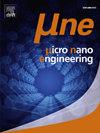三维打印聚合物层氮化硅微束谐振器的能量耗散
IF 3.1
Q2 ENGINEERING, ELECTRICAL & ELECTRONIC
引用次数: 0
摘要
本文分析了共振多层双箝位微光束在200 ~ 500khz范围内的主要耗散机制。该器件由2μm厚的氮化硅(E≈160 GPa)光束和双光子聚合法制备的聚合物IP-Dip (E≈4 GPa)层组成。用激光多普勒测振仪测量了器件在高真空条件下的共振振动和能量耗散。0.05 Pa)。实验结果与理论计算结果和有限元计算结果进行了比较。以IP-Dip层的本征耗散为主导的质量因子已被证明与聚合物厚度有很强的依赖性。在此基础上,建立了聚合物层内本征耗散的粘性模型。本文章由计算机程序翻译,如有差异,请以英文原文为准。

Energy dissipation in silicon nitride microbeam resonators with a 3D-printed polymer layer
We present an analysis of the main mechanisms of dissipation of resonant multilayer double-clamped microbeams in the frequency range 200 to 500 kHz. The devices consist of thick silicon nitride (E 160 GPa) beams covered with a polymer IP-Dip (E 4 GPa) layer fabricated by two-photon polymerization. A laser-Doppler vibrometer was used to measure the resonant vibrations and energy dissipation of the devices in high vacuum (< 0.05 Pa) at room temperature. The experimental findings were compared with theoretical and finite element method (FEM) results. The quality factor, dominated by the intrinsic dissipation in the IP-Dip layer, has proven to have a strong dependence on polymer thickness. On this basis, a viscous model for intrinsic dissipation in a polymer layer was formulated.
求助全文
通过发布文献求助,成功后即可免费获取论文全文。
去求助
来源期刊

Micro and Nano Engineering
Engineering-Electrical and Electronic Engineering
CiteScore
3.30
自引率
0.00%
发文量
67
审稿时长
80 days
 求助内容:
求助内容: 应助结果提醒方式:
应助结果提醒方式:


